Overview
Clans of Caledonia, designed by Juma Al-JouJou, is an economic game that takes place in 19th century Scotland. In the game each player takes on the role of a Scottish clan as they work to expand their holdings and increase their wealth. Clans of Caledonia is an area control meets resource management meets market manipulation game. Expanding your holdings requires lots of money and the only way to earn money is by expanding intelligently, fulfilling contracts, and manipulating the common market to buy low and sell high.
Each round the players take turns performing one of several actions until all players have passed. Then an end-of-round scoring is performed before moving into the next round. There are five rounds in total and a final scoring takes place after the completion of the fifth round. Then the player who has accumulated the most glory (victory points) will be declared the winner.
At this point, unless you’re interested in finding out how the game is played, you can scroll down to the Thoughts section to find out what I think about Clans of Caledonia.
Setup
First, the game board is assembled and placed in between the players (in one of sixteen possible configurations) and four port tiles are chosen at random and placed into their locations at the four corners of the game area. Next to this is placed the market board which is set to its starting configuration using the round discs which are provided to track the market’s fluctuations. Then the Export board is placed nearby. Five scoring tokens are selected randomly and placed into the notches at the edge of this board. The Export tiles are shuffled and placed into face-down stacks and a number of these are then turned face up into their locations on the Export board.

Now a starting player is selected and the players are each given a player board along with an Export box tile. Each player chooses a color and takes their pieces which are then placed into their positions on the player board. Their turn tracker is placed on the Export board in turn order and their Glory token is placed at the 0 position on the score tracker. The Export goods tokens are also placed here. After this has been done, a number of Clan tiles are placed onto the table along with a randomly selected Starting tile. Each Clan has its own unique ability that will provide the player that controls them with some kind of benefit. The players take turns selecting the Clan that they want to play with and take the goods depicted on the Starting tile. After selecting their Clans, the players will take turns placing their initial workers on the board and the game is ready to be played.
The Actions
During each player’s turn, they will select from one of 7 different actions to perform. After performing their action, play passes to the next player and then the next and so forth until all players have passed. When a player passes, their turn tracker moves into the appropriate turn order spot for the next round and they will receive the monetary amount listed on that spot. So the players will be going in the order in which they passed during the previous round. The available actions are:
- Trade (buy or sell goods on the Market board)
- Obtain an export contract (depending on the round, the player might earn money for taking a contract or might have to pay money to obtain one)
- Expand (place units from the player board into the playing area)
- Upgrade shipping (allows players to build things further and further away from one another)
- Upgrade technology (upgrades workers so that they earn more money)
- Fulfill an export contract (turn in the goods required, reap the rewards, and adjust the export goods tokens accordingly)
- Hire a merchant (pay 4 bucks to acquire an extra merchant which allows you to utilize the Market board more)
- Provided you have the shipping to reach it, utilize a port tile (place a port token next to the port that is being used and do whatever the port allows you to do). Each port can only be used by each player once per game.

Just so you can understand how the game is played, let’s discuss these in a little more detail. I will try to exercise brevity and keep these discussions short.
Expanding
Each meeple on a player’s mat has a cost associated with it and each hexagon on the playing area also has a cost associated with it. In order to place a unit on the board, the player must pay both the cost associated with the unit and the cost of the hexagon. For instance, placing a Distillery (which has a cost of 10) into a field that is labeled with a cost of 4 would cost the player 14 bucks. There are certain placement rules that must be taken into account, too. Miners can only be placed onto hexagons which depict mountains, for instance, and each unit that a player puts down (with the exception of the units placed during setup) must be placed adjacent to another unit owned by that player.

If a player places a unit next to a construction (i.e. anything that is NOT a miner or a woodcutter) then they will be eligible to take advantage of the neighborhood bonus which I will discuss in the Market board section. Also, the requirements for adjacency can be changed by players upgrading their shipping and I will discuss this in the section on shipping.
Contracts
Obtaining and fulfilling contracts sits at the heart of Clans of Caledonia. Ignore this aspect of the game and you probably will not do very well. Obtaining a contract during the first few rounds of the game is going to either earn you money or cost you nothing. Later rounds will find the contracts getting progressively more expensive to obtain. Each player can only have one unfulfilled contract at a time (one clan will allow you to hold an extra one).
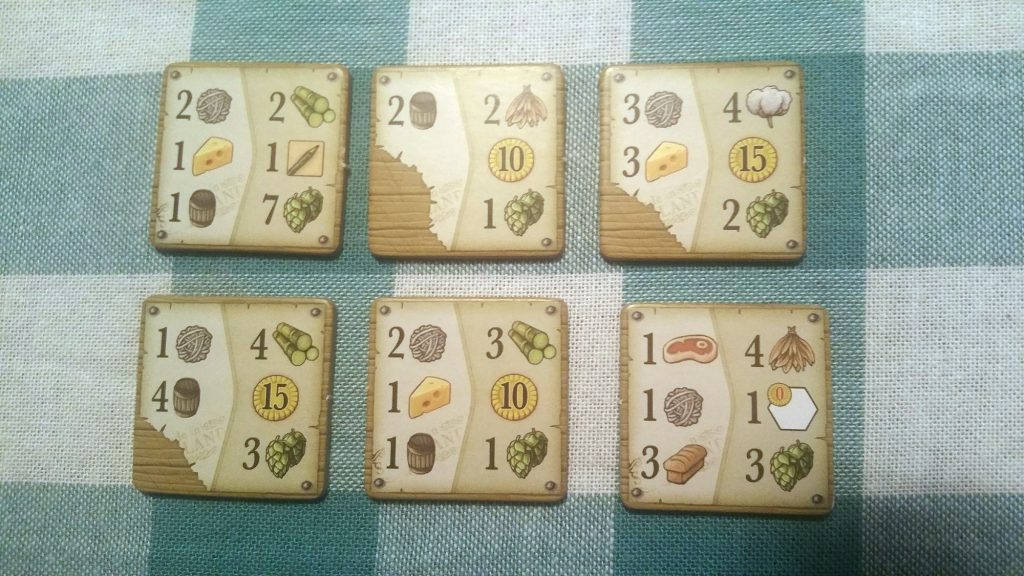
The left side of a contract shows the goods which must be relinquished to the general supply in order for the contract to be fulfilled. The right side shows the reward for fulfillment. The player may earn money or a discount of some sort. These contracts will also cause the export goods tokens to move along the score track. At the end of the game, the players will earn points for each of the different export goods icons on the contracts that they have fulfilled and the number of points earned will be directly affected by the tokens’ positions on the track. There are also Hops shown on some of these contracts which will earn the players points at the end of the game.
The Market
The Market board is divided into several columns – each column representing a type of good. At the top of the Market board is a purchase area. In order for a player to purchase an item, they must place at least 1 merchant into the purchase area of the item they wish to purchase. Then they will pay an amount of money equal to the number of merchants times the current price for the item being purchased. After they pay their money and receive their goods, the price marker for that good will move upwards one time for each good that was purchased. This will cause future purchases to become more expensive. At the bottom of the Market board is a sell area. Here players can sell goods by placing their merchants here and relinquishing a number of goods equal to the number of merchants. Then they will receive money equal to the number of relinquished goods times the current price for those goods. Then the price marker adjusts downwards which makes future purchases less expensive and future selling of that particular good less lucrative. A player may never place merchants in both the purchase and sell areas of the same good during the same game round.

Normally a player would have to use their entire action to interact with the Market board. However, it might be possible for them to use a build action to obtain a neighborhood bonus. It works like this: if a player builds a unit next to another player’s construction, then they are allowed to use their merchants to buy a certain amount of the items that their neighbor’s construction produces at a discount. For instance, if I place any kind of unit next to my opponent’s Bakery, I will be entitled to purchase bread from the Market board at a discount since that’s what the Bakery produces. In order to take advantage of this, though, I still need to use my merchants and that is why having plenty of merchants available is important. More merchants equals more options.
Shipping
Shipping is important for two reasons – expansion and end-of-game scoring. Normally you can only build something in a hexagon that is directly adjacent to one of the other hexagons that you’ve currently got something built upon as long as it doesn’t require crossing a body of water. This is fine at first, but as the board becomes crowded, the opportunities for expanding in this way become few and far between. At some point, you’re going to need to cross a river or a loch to build further away and this is achieved by upgrading your shipping. Each level of shipping allows you to skip over an extra water space. There are five levels in all and each upgrade will cost you four money.

Anatomy of a Round
Each round consists of four distinct phases:
- Preparation phase: the Scoring tile from the previous round is flipped over to signify that it has been used. Any empty spots on the Export board are filled up with new Export contract tiles. The players retrieve any merchants of theirs from the Market board.
- Action phase: players keep taking actions in turn order until all players have passed.
- Production phase: units on the game board produce goods and income.
- Scoring phase: players receive Glory according to the conditions on the current turn’s Scoring tile.
The Preparation phase is fairly self-explanatory and I have already gone through the different actions, so let’s talk about how Production and Scoring happen.
Production and Scoring
Each unit on a player’s player board is sitting on top of an icon. When that unit has been placed on the game board, the icon that it was sitting on is exposed. During the Production phase, each player will receive income based on the number and type of workers that they have deployed. Upgrading your technology during your turn will increase the amount of income that each of these workers produces.

Then you receive basic goods which are determined by the exposed icons. For instance, one Field produces two wheat. If I had two Fields exposed, I would receive four wheat during this phase. After basic goods have been produced, players who have constructed processing facilities (bakeries, cheese dairies, and distilleries) will have the opportunity to convert basic goods into processed goods (i.e. – milk turns into cheese at a cheese dairy) at a ratio of one good per processing facility. These goods can be used in later turns to fulfill contracts, earn money at the Market, and will also be worth Glory at the end of the game.
End of Game
The game comes to an end at the conclusion of the fifth round. At this time players will earn points from several different things and whoever has the highest score will win. Points are awarded for:
- Each leftover basic good = 1 point
- Each leftover processed good = 2 points
- Each 10 money = 1 point
- Each Hops symbol on fulfilled contracts = 1 point each
- The Export good that has moved the least = 5 points each
- The Export good that is in second place = 4 points each
- The Export good that has moved the most = 3 points each
- Points for the most fulfilled Export contracts
- Points for the most settlements connected by shipping. A settlement consists of a cluster of units that are adjacent but not separated by water.
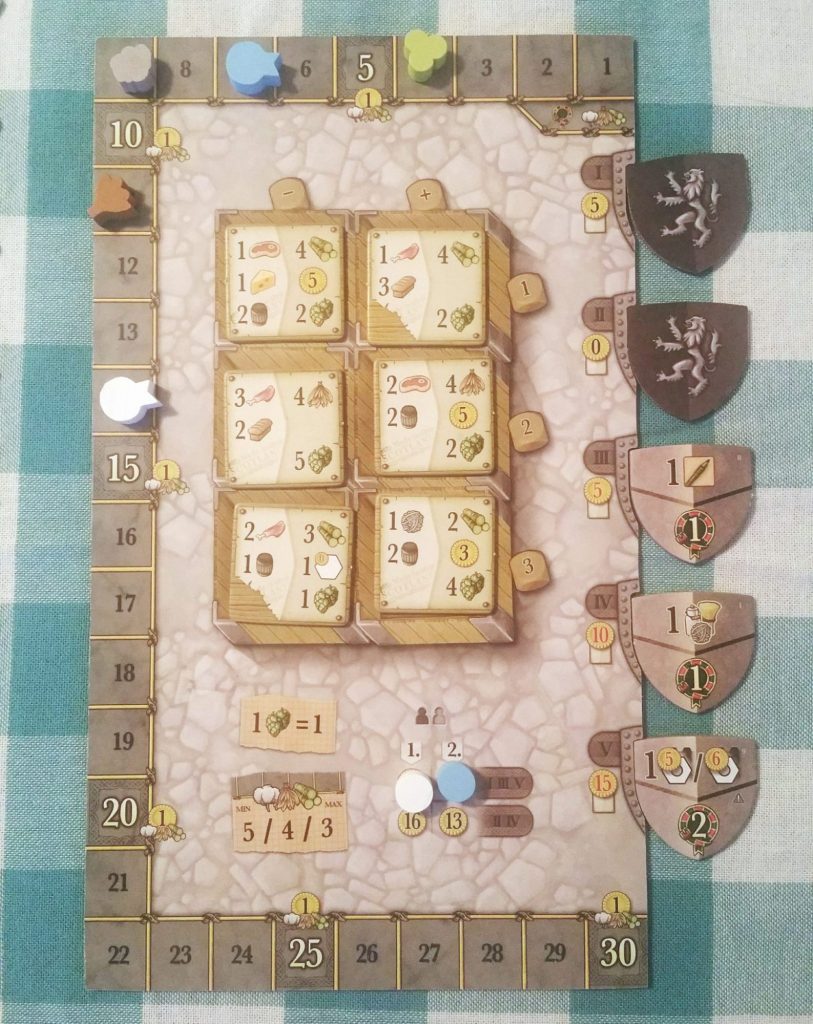
Thoughts
Let’s perform a quick imagination exercise. Think about your favorite movie director. Next, picture your favorite actors. Now, imagine that your favorite writer penned a script that was turned into a movie featuring those actors and directed by that director and, while you’re at it, imagine that your favorite composer is doing the musical score for the film. And the film is releasing on your birthday. Sounds pretty amazing, doesn’t it? Well, that’s the type of game that Clans of Caledonia is. Each element of the game – from the designer to the artwork to the mechanics – has come together in the perfect synergistic union.
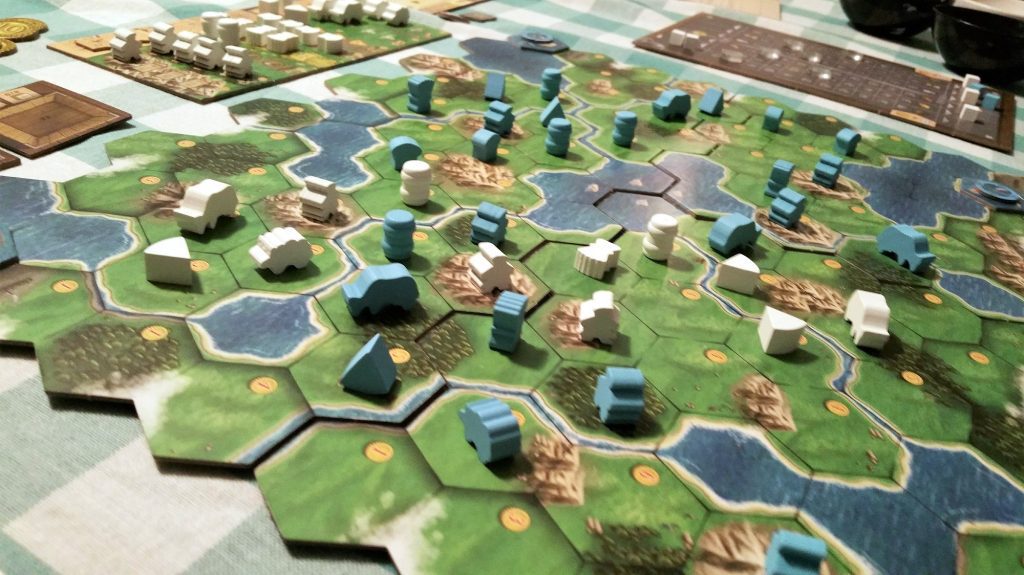
It begins with the game’s looks. Klemens Franz’s artwork is always amazing and it is particularly so in Clans of Caledonia. The box art transports you back to a time and place long gone. The soft color palette is dreamlike and comforting in its quality. It makes you almost wish you were there. It makes you long to open the box to see what’s waiting inside and, having looked inside, he doesn’t disappoint. Clans of Caledonia is a positive explosion of color that beckons to you and sucks you in. It’s just a beautiful game. It’s hard to tell who was more fortunate here – Juma Al Joujou for landing Klemens Franz as his artist or Klemens Franz for having the opportunity to do the illustrations for Juma’s game. Either way, the real beneficiaries of this union are the players. It doesn’t just stop at the artwork either. The components for this game are stellar. The cardboard is nice and thick. The wooden pieces are well designed and have a nice tactile quality about them. The Player Aids stands as a shining example of what every player aid should be. Visually, Clans of Caledonia is one of the most well put together games that I have ever played.
But a game does not exist on looks alone. Looks will only get you so far. In a previous review that I wrote, I wagered that Photosynthesis stood a better than good chance of winning the next Spiel des Jahres. Now I’m not so sure. It would not surprise me if Clans of Caledonia was in the running as well. Mechanically, Clans of Caledonia’s just a stellar game.
One thing that makes Clans of Caledonia really shine are the variable player powers. Each clan has some kind of special ability that not only helps to guide the players in their decision making but is also a historical reflection of what the clan in question was actually known for. For instance, Clan Cunningham allows the player that is playing them to sell any milk they might have for 8 money each at the end of the Production phase. From the rulebook:
“Cunninghame is the northern part of Ayrshire, one of the most agriculturally fertile regions of Scotland where raising cattle has traditionally been important. ‘Cuinneag’ is Gaelic for milk pail and ‘ham’ means village in Old English.”
As you can see, the clan’s ability is tailored to the clan’s actual historical significance. I just think this aspect of the game is really cool. As to whether or not these powers are well-balanced, all I can say is that opinions may vary, but each time that I have played the game, I invariably find myself wishing I had the other player’s ability while they’re sitting across from me wishing that they had mine. If that isn’t a sign of good balance, I don’t know what is.

At the heart of the game is the market. While each player earns money from their workers and perhaps their clan ability, it’s never enough to fully accomplish everything they might want to do. This is why careful manipulation of the market is crucial to success. It pays to strike when the iron’s hot. If wheat is cheap right now, for instance, it would behoove you to snatch some up and position yourself to use that wheat in some beneficial way in future rounds such as building a distillery to turn it into whiskey – even if you aren’t producing any wheat of your own! This works out even better if you’ve lined up an Export contract that calls for whiskey. And positioning yourself to take advantage of neighborhood bonus opportunities is also of tantamount importance. Money is very tight in this game so any opportunity to save money or make a profit is an opportunity that shouldn’t be squandered.
Also important is the fulfillment of contracts. In fact, this is probably the most important aspect of the game. Five out of the nine end-of-game scoring criteria are centered around fulfilled Export contracts. And this is about the only negative aspect of the game that I can think of. I’m not a big fan of randomness in board games and the randomness that comes with the introduction of new contracts can be very unwelcome. If you’re doing poorly and then suddenly get a string of Export contracts that just happen to show goods that you just happen to have on hand, it can really turn the game around for you. In fact, it can be so swingy that it can rocket you from dead last into the first place position. Contract fulfillment is so important, in fact, that I have only played one game where the winner was not the person that managed to win the contract game. While this intense focus on fulfilling contracts could be viewed as a negative by some, I will say that no effort has been made to conceal this from the players. The scoring system makes it very clear that the majority of the points at the end of the game are going to come from fulfilling contracts, so players would be remiss to ignore them.

For me, though, the aspect of Clans of Caledonia that really makes the game exciting for me is the expansion aspect. At the start of the game, there’s plenty of room for expansion, but this quickly becomes not the case as you start rubbing against the other players. It becomes a race for the cheap plots and then a race to cut other people off from expanding into your turf while trying to expand into theirs. Anywhere you can get a foothold means more flexibility and, potentially, more points at the end of the game. There’s also a challenge to build defensively in such a way as to prevent other people from being able to take advantage of the neighborhood bonuses provided by the buildings which you have constructed.
There’s a lot to consider here. Each and every decision that you make has far-reaching consequences. Every dollar is hard earned and hard spent. Every opportunity taken is another opportunity squandered and it’s never easy to determine whether your decisions were the best or the most efficient until the final scores are tallied at the end. And this is all accomplished using tried and true mechanics. Constructing things, variable player powers, market manipulation… these have all been used in other games before. But this game manages to remix those mechanics into something new and exciting. While Clans of Caledonia doesn’t reinvent the wheel, it reimplements it masterfully.
So, does Clans of Caledonia deserve all of the praise and adulation that has been heaped upon it? Without a doubt. I simply cannot get enough of this amazing game and I cannot wait to see what Juma Al-Joujou comes up with next.


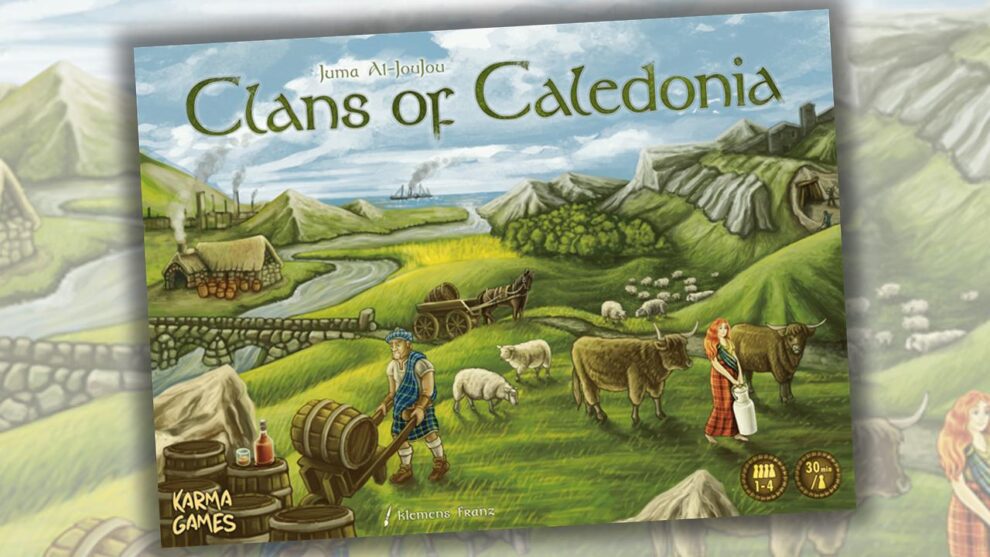
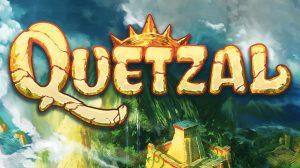

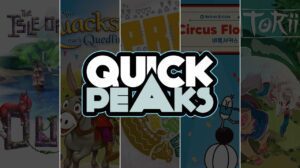





Add Comment